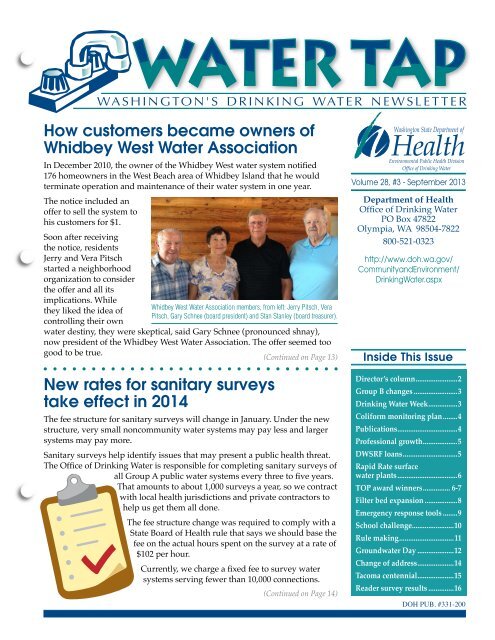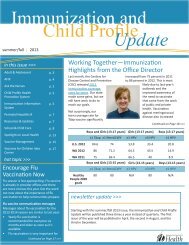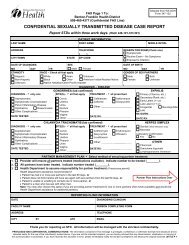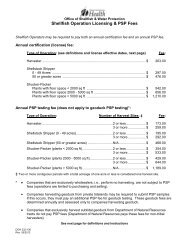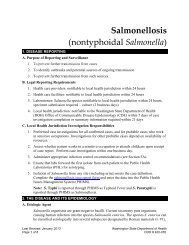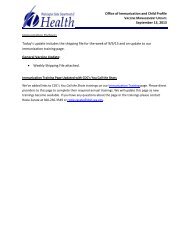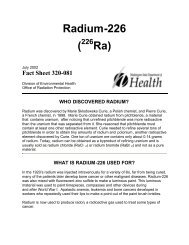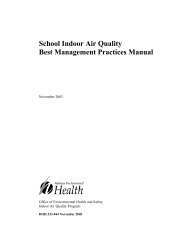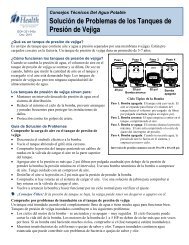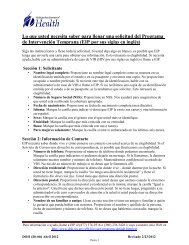Water Tap - Washington State Department of Health
Water Tap - Washington State Department of Health
Water Tap - Washington State Department of Health
Create successful ePaper yourself
Turn your PDF publications into a flip-book with our unique Google optimized e-Paper software.
How customers became owners <strong>of</strong><br />
Whidbey West <strong>Water</strong> Association<br />
In December 2010, the owner <strong>of</strong> the Whidbey West water system notified<br />
176 homeowners in the West Beach area <strong>of</strong> Whidbey Island that he would<br />
terminate operation and maintenance <strong>of</strong> their water system in one year.<br />
The notice included an<br />
<strong>of</strong>fer to sell the system to<br />
his customers for $1.<br />
Soon after receiving<br />
the notice, residents<br />
Jerry and Vera Pitsch<br />
started a neighborhood<br />
organization to consider<br />
the <strong>of</strong>fer and all its<br />
implications. While<br />
Whidbey West <strong>Water</strong> Association members, from left: Jerry Pitsch, Vera<br />
they liked the idea <strong>of</strong><br />
Pitsch, Gary Schnee (board president) and Stan Stanley (board treasurer).<br />
controlling their own<br />
water destiny, they were skeptical, said Gary Schnee (pronounced shnay),<br />
now president <strong>of</strong> the Whidbey West <strong>Water</strong> Association. The <strong>of</strong>fer seemed too<br />
good to be true.<br />
(Continued on Page 13)<br />
New rates for sanitary surveys<br />
take effect in 2014<br />
The fee structure for sanitary surveys will change in January. Under the new<br />
structure, very small noncommunity water systems may pay less and larger<br />
systems may pay more.<br />
Sanitary surveys help identify issues that may present a public health threat.<br />
The Office <strong>of</strong> Drinking <strong>Water</strong> is responsible for completing sanitary surveys <strong>of</strong><br />
all Group A public water systems every three to five years.<br />
That amounts to about 1,000 surveys a year, so we contract<br />
with local health jurisdictions and private contractors to<br />
help us get them all done.<br />
The fee structure change was required to comply with a<br />
<strong>State</strong> Board <strong>of</strong> <strong>Health</strong> rule that says we should base the<br />
fee on the actual hours spent on the survey at a rate <strong>of</strong><br />
$102 per hour.<br />
Currently, we charge a fixed fee to survey water<br />
systems serving fewer than 10,000 connections.<br />
(Continued on Page 14)<br />
Environmental Public <strong>Health</strong> Division<br />
Office <strong>of</strong> Drinking <strong>Water</strong><br />
Volume 28, #3 - September 2013<br />
<strong>Department</strong> <strong>of</strong> <strong>Health</strong><br />
Office <strong>of</strong> Drinking <strong>Water</strong><br />
PO Box 47822<br />
Olympia, WA 98504-7822<br />
800-521-0323<br />
http://www.doh.wa.gov/<br />
CommunityandEnvironment/<br />
Drinking<strong>Water</strong>.aspx<br />
Inside This Issue<br />
Director’s column........................2<br />
Group B changes.........................3<br />
Drinking <strong>Water</strong> Week.................3<br />
Coliform monitoring plan.........4<br />
Publications..................................4<br />
Pr<strong>of</strong>essional growth....................5<br />
DWSRF loans...............................5<br />
Rapid Rate surface<br />
water plants..................................6<br />
TOP award winners................ 6-7<br />
Filter bed expansion...................8<br />
Emergency response tools.........9<br />
School challenge........................10<br />
Rule making...............................11<br />
Groundwater Day.....................12<br />
Change <strong>of</strong> address.....................14<br />
Tacoma centennial.....................15<br />
Reader survey results...............16<br />
DOH PUB. #331-200
The<br />
Director’s Column<br />
by Denise Addotta Clifford<br />
The last time I brought home a C-, I was in trouble…<br />
The 2013 Report Card for <strong>Washington</strong>’s Infrastructure is in, and it isn’t pretty.<br />
The report card, compiled by the Seattle Section <strong>of</strong> the American Society <strong>of</strong> Civil Engineers<br />
(ASCE), concludes that while there are bright spots, infrastructure maintenance is inadequate in<br />
<strong>Washington</strong> and the state lacks planned, guaranteed funding to support it.<br />
Drinking water got a C-. We can do better! Actually, we did do slightly better than the national<br />
grade for drinking water infrastructure. ASCE’s 2013 Report Card for America’s Infrastructure<br />
gave drinking water a D. But that’s small comfort.<br />
<strong>Washington</strong>’s evaluation team looked at five criteria: <strong>Water</strong> system capacity and supply, water system condition, funding,<br />
operation and maintenance, and public health and safety.<br />
The report card team noted that <strong>Washington</strong>’s letter grade does not tell the story <strong>of</strong> what’s really happening in our state.<br />
They correctly point out that a number <strong>of</strong> small and medium-sized water systems face serious needs.<br />
“In general, the smaller systems have a higher probability <strong>of</strong> having problems, since they do not have the customer base<br />
or financial wherewithal to support regular maintenance and upgrades,” the report noted. It also pointed out that many<br />
small systems depend on grants and low-interest loans to maintain the integrity <strong>of</strong> their drinking water because their rate<br />
structures are too low. That is not a sustainable way to run a water system.<br />
It goes without saying that many small, medium, and larger water systems in <strong>Washington</strong> are in great shape. They<br />
regularly invest in maintenance, upgrades, staff training, and equipment replacement. EPA’s most recent needs assessment<br />
places <strong>Washington</strong>’s infrastructure needs at about $9.5 billion.<br />
ASCE made six recommendations for improving the state’s drinking water infrastructure:<br />
1. Fully fund the Public Works Assistance Account. (Note: the 2013-15 biennial budget doesn’t include funding for the<br />
Public Works Assistance Account.)<br />
2. Encourage the federal government to fund the Drinking <strong>Water</strong> <strong>State</strong><br />
Revolving Fund (DWSRF). (Note: We expect DWSRF loans to total<br />
about $100 million this year.)<br />
3. Encourage smaller water systems that are able to connect to larger<br />
systems to do so.<br />
4. Educate drinking water customers that good water requires adequate<br />
funding. Some capital funding must be earned through the rate<br />
structure.<br />
5. Raise awareness among elected bodies that govern water systems <strong>of</strong><br />
the need to develop a system to acquire capital reserves for long-term<br />
planning once their system is operating well again.<br />
6. Support the <strong>Department</strong> <strong>of</strong> Ecology’s water rights division to enable<br />
jurisdictions to acquire water rights as needed.<br />
These recommendations align nicely with the direction the Office <strong>of</strong><br />
Drinking <strong>Water</strong> is taking. We focus on building technical, financial and<br />
managerial capacity among smaller water systems, and tools such as<br />
consolidation <strong>of</strong> struggling small water systems.<br />
I don’t know about you, but I don’t want to settle for a C-. It’s going to<br />
take all <strong>of</strong> us working together to move drinking water to its rightful<br />
place on the infrastructure honor roll.<br />
A fond farewell<br />
I am leaving the Office <strong>of</strong> Drinking<br />
<strong>Water</strong> this month to become<br />
government relations director for the<br />
<strong>Department</strong> <strong>of</strong> Ecology.<br />
Organizations thrive, grow and do<br />
even more incredible things when<br />
a leader with new vision and fresh<br />
perspective joins the team. It is a<br />
healthy dynamic, and one that I<br />
think organizations could do more<br />
to embrace. My leaving sets the<br />
stage for someone else to have the<br />
fabulous opportunity I’ve had to lead<br />
a creative, passionate team <strong>of</strong> people<br />
in carrying out the essential mission<br />
<strong>of</strong> ensuring safe and reliable drinking<br />
water.<br />
It has been an honor and a pleasure<br />
to work with all <strong>of</strong> you.<br />
<strong>Washington</strong> <strong>State</strong> <strong>Department</strong> <strong>of</strong> <strong>Health</strong><br />
2 <strong>Water</strong> <strong>Tap</strong> • September 2013
Group B system<br />
designers, applicants:<br />
Take note!<br />
Revisions to the state’s Group B Rule will take effect<br />
January 1, 2014. If you plan to submit an application<br />
for approval <strong>of</strong> a new or expanding Group B system<br />
in the next few months, read on.<br />
We will review the design <strong>of</strong> a new or expanding<br />
Group B water system received on or after January<br />
1, 2014, based on the standards in the revised Group<br />
B rule. The revised rule reflects a higher standard for<br />
design approval.<br />
Group B water systems serve fewer<br />
than 15 connections and fewer than<br />
25 people per day. The state’s 13,000<br />
Group B water systems serve about<br />
110,000 people. That’s about<br />
2 percent <strong>of</strong> our population.<br />
Group B water systems are<br />
regulated under chapter<br />
246-291 <strong>of</strong> the<br />
<strong>Washington</strong><br />
Administrative Code.<br />
We will review the design <strong>of</strong> a new or expanding<br />
Group B water system received on or before December 31, 2013, based on the existing rule, even if our<br />
review process extends beyond January 1. We will return incomplete submittals received before December<br />
31 to the applicant. You cannot be “vested” under the existing rule if you submit an incomplete submittal.<br />
Consider the timing <strong>of</strong> your design submittal, and apply the appropriate rule and standards based on your<br />
anticipated submittal date.<br />
In addition to creating a higher standard for design approval <strong>of</strong> new and expanding systems, the revisions<br />
to the Group B rule affect nonexpanding existing Group B systems. Visit our Group B resource page to<br />
learn more. While you’re there, take time to review our new Group B Design Guidelines, Group B Design<br />
Workbook, and the resources we’ve developed for Group B water system applicants, owners, designers,<br />
and consumers.<br />
Nominate now for 2014<br />
Drinking <strong>Water</strong> Week<br />
If you know <strong>of</strong> a water system or waterworks operator who deserves<br />
recognition, tell us. We will celebrate safe and reliable drinking water<br />
during Drinking <strong>Water</strong> Week, May 4-10, 2014.<br />
Fill out and submit an online nomination form to tell us why we should<br />
honor your nominee. We will accept nominations until February 1, 2014.<br />
Here’s the URL for drinking water week http://www.awwa.org/<br />
resources-tools/public-affairs/public-affairs-events/drinking-waterweek.aspx<br />
And the form https://fortress.wa.gov/doh/opinio/s?s=7391<br />
<strong>Washington</strong> <strong>State</strong> <strong>Department</strong> <strong>of</strong> <strong>Health</strong><br />
3 <strong>Water</strong> <strong>Tap</strong> • September 2013
Publications explain coliform monitoring,<br />
the Groundwater Rule and E. coli<br />
response planning<br />
Chance favors the prepared mind. –Louis Pasteur<br />
All Group A systems must collect samples for coliform bacterial analysis. In addition, the Coliform Rule<br />
and the Groundwater Rule require systems to have a plan in place to address E. coli if it is detected.<br />
Having a plan can bring success and confidence that you are providing safe and reliable water to your<br />
customers.<br />
To help you succeed, we developed Preparing a Coliform Monitoring Plan Guidance. It comes in three<br />
versions, so take a moment to pick the one that’s right for you:<br />
1. Large or multiple-source systems (331-036)<br />
2. Systems with one source <strong>of</strong> supply (331-240)<br />
3. Consecutive and wholesale systems (331-475)<br />
These publications include guidance on triggered source monitoring required by the Groundwater Rule<br />
and incorporate the concept <strong>of</strong> planning for the occurrence <strong>of</strong> E. coli bacteria in your water system.<br />
Each version has instructions on coliform monitoring, templates, checklists, and examples <strong>of</strong> completed<br />
plans.<br />
Groundwater Rule<br />
In response to a total coliform-positive routine sample, systems with active groundwater sources must<br />
collect source samples. This sampling is called “triggered source monitoring” (TSM). To understand<br />
that better, check out the information in your coliform monitoring plan (CMP) publication. If you have<br />
multiple groundwater sources, it is possible to reduce your TSM requirement by demonstrating in the<br />
CMP that a specific source cannot supply water to a particular routine sample site.<br />
E.coli response<br />
We also included guidance for an E.coli response plan. If your system ever gets an E.coli-positive sample<br />
result, you will want to be prepared! Our checklists will help you understand whether you are prepared<br />
and provide specific tasks you can complete to help you respond. By preparing before an event, you can<br />
best address it without panic and expensive missteps that upset customers needlessly.<br />
Again, planning is a tool for success. Good coliform monitoring plans will help you get there.<br />
New & Revised Publications<br />
Noncommunity Small <strong>Water</strong> System Management Program Guide (331-474). New!<br />
August 2013. This 53-page guide will help you develop a tailored management program<br />
you can use to ensure your water system remains capable <strong>of</strong> meeting your business and<br />
customer needs.<br />
Troubleshooting Bladder Pressure Tanks (331-342). Revised April 2013. This two-page<br />
tech tip explains what a bladder tank is, how it works, the functions it serves, and how to<br />
troubleshoot problems. Also available in Spanish.<br />
Our publications are online at https://fortress.wa.gov/doh/eh/dw/publications/publications.cfm<br />
<strong>Washington</strong> <strong>State</strong> <strong>Department</strong> <strong>of</strong> <strong>Health</strong><br />
4 <strong>Water</strong> <strong>Tap</strong> • September 2013
Operators, why wait?<br />
Start working on your pr<strong>of</strong>essional growth requirement now<br />
Beat the stress <strong>of</strong> trying to find relevant training in your geographical area, BAT exam dates and locations that<br />
fill too quickly, and finding dates that fit into already busy schedules.<br />
December 31, 2015, is the new reporting period deadline for operators and BATs certified before January 1, 2013.<br />
If you start planning now, you can have your pick <strong>of</strong> the coursework, exams, training dates, times, and locations.<br />
Anyone certified after January 1, 2013, has until December 31, 2018, to meet the requirement.<br />
If your original certification date is<br />
You must meet the pr<strong>of</strong>essional growth requirement between:<br />
Before 1/1/2010 1/1/2013 and 12/31/2015*<br />
Between 1/1/2010 and 12/31/2012 Your original certification date and 12/31/2015*<br />
Between 1/1/2013 and 12/31/2015 Your original certification date and 12/31/2018*<br />
*and in each three-year reporting period thereafter<br />
Check Your Status Online<br />
Certified waterworks operators and BATs can check their pr<strong>of</strong>essional growth status and find<br />
detailed information about the pr<strong>of</strong>essional growth requirement on the <strong>Washington</strong> Certification<br />
Services webpage.<br />
DWSRF loans will finance projects large and small<br />
The state Public Works Board approved 49 water systems throughout the state for low-interest loans from<br />
the Drinking <strong>Water</strong> <strong>State</strong> Revolving Fund (DWSRF).<br />
The loans range from about $100,000 to $12 million and include an array <strong>of</strong> projects, such as replacing<br />
failing infrastructure and building a large surface water treatment plant. Interest rates are 1 to 1.5 percent.<br />
The Office <strong>of</strong> Drinking <strong>Water</strong> used four main criteria to rank applications:<br />
• Projects that address the most serious risk to public health<br />
• Projects necessary to ensure compliance with the Safe Drinking <strong>Water</strong> Act<br />
• Projects that address current compliance actions or an impending public health threat<br />
• Financial need<br />
To better meet construction season timing needs, we will transition<br />
back to a fall loan cycle. This year, we focused on projects that were<br />
previously on the Public Works Assistance Account funding list, but<br />
went unfunded due to state budget cuts. Our next loan cycle will be<br />
the fall <strong>of</strong> 2014.<br />
For more information about the DWSRF program, visit our<br />
website: http://www.doh.wa.gov/CommunityandEnvironment/<br />
Drinking<strong>Water</strong>/<strong>Water</strong>SystemAssistance/<br />
Drinking<strong>Water</strong><strong>State</strong>RevolvingFundDWSRF.aspx<br />
<strong>Washington</strong> <strong>State</strong> <strong>Department</strong> <strong>of</strong> <strong>Health</strong><br />
5 <strong>Water</strong> <strong>Tap</strong> • September 2013
Rapid-rate surface water filtration plants keep edge<br />
Results for 2012 are in! Turbidity monitoring data show that our conventional and direct filtration surface water<br />
treatment plants continue to perform above regulatory standards—and provide better public health protection.<br />
The filtered water turbidity goals we adopted for these systems are not regulatory. Instead, we encourage<br />
systems to achieve water quality by using existing facilities, which provides a larger margin <strong>of</strong> safety. The<br />
performance <strong>of</strong> rapid-rate filters for turbidity (particle) removal is a key element in protecting consumers from<br />
microbial contaminants and maximizing public health.<br />
Treatment Optimization<br />
Program’s (TOP) filtered<br />
water turbidity goals:<br />
1. Meet 0.10 nephelometric<br />
turbidity units (NTU)<br />
or less in 95 percent<br />
<strong>of</strong> the maximum daily<br />
combined filter effluent<br />
(CFE) measurements<br />
taken during the year.<br />
2. Never exceed 0.30 NTU in<br />
any CFE measurement.<br />
Other news<br />
At this time, the City <strong>of</strong><br />
Lynden is constructing a new<br />
conventional treatment plant<br />
to replace one built in 1926.<br />
The City <strong>of</strong> Tacoma is<br />
constructing its first<br />
conventional filtration<br />
plant to address treatment<br />
requirements <strong>of</strong> the Long<br />
Term 2 Enhanced Surface<br />
Turbidity reduction performance by all rapid rate treatment plants in <strong>Washington</strong> from 2001 through 2012. Data points<br />
are the average <strong>of</strong> all included treatment plants for each year.<br />
<strong>Water</strong> Treatment Rule. This filtration technology has been in use for many years. It appears it will be a preferred<br />
method for many years to come.<br />
For more information<br />
To learn more about TOP and treatment optimization, visit Performance <strong>of</strong> Rapid Rate Filtration Plants in<br />
<strong>Washington</strong> online.<br />
TOP award winners<br />
The Treatment Optimization Program (TOP) awards bronze, silver,<br />
and gold certificates to systems the first time they meet the turbidity<br />
goals for 3-, 5-, and 10-consecutive years, respectively. This year, three<br />
systems earned silver certificates and two earned bronze certificates.<br />
Congratulations! See winners on page 7.<br />
Our award program started in 2009. Since then, 37 water systems have<br />
earned awards for excellent treatment performance. Besides meeting<br />
the goals, the award winners had to remain free <strong>of</strong> any drinking water<br />
violations during the evaluation period.<br />
Dale Wardell, chief operator for the Skagit County PUD Judy Reservoir treatment plant. This plant was one <strong>of</strong><br />
the best at lowering finished water turbidity during 2012 and has been near the top for more than 10 years.<br />
<strong>Washington</strong> <strong>State</strong> <strong>Department</strong> <strong>of</strong> <strong>Health</strong><br />
6 <strong>Water</strong> <strong>Tap</strong> • September 2013
TOP winners... (Continued from Page 6)<br />
2013 TOP Award Recipients<br />
In recognition <strong>of</strong> excellent performance<br />
Gold Award<br />
10 or more years <strong>of</strong> continuously<br />
optimized performance<br />
• Arlington <strong>Water</strong><br />
<strong>Department</strong> (2001-2012)<br />
• Lake Whatcom <strong>Water</strong> and<br />
Sewer District – South Shore<br />
<strong>Water</strong> System (2001-2012)<br />
• Pasco <strong>Water</strong> <strong>Department</strong><br />
(2001-2012)<br />
• Skagit County PUD #1<br />
– Judy Reservoir System<br />
(2001-2012)<br />
Silver Award<br />
5 to 9 years <strong>of</strong> continuously<br />
optimized performance<br />
• Blakely Island Maintenance<br />
Commission (2008-2012) *<br />
• <strong>Department</strong> <strong>of</strong> Energy 200W<br />
(2007-2012)<br />
• City <strong>of</strong> Kelso (2006-2012)<br />
• Lake Chelan Reclamation<br />
District (2005-2012)<br />
• Lummi Island Scenic Estates<br />
Community Club (2008-<br />
2012) *<br />
• Ryderwood Improvement &<br />
Service Association (2008-<br />
2012) *<br />
• Stevens Pass <strong>Water</strong> System<br />
(2005-2012)<br />
Bronze Award<br />
3 or 4 years <strong>of</strong> continuously<br />
optimized performance<br />
• City <strong>of</strong> Everett <strong>Department</strong><br />
<strong>of</strong> Public Works (2009-2012)<br />
• Island View LUD 9 (2010-<br />
2012) *<br />
• City <strong>of</strong> Leavenworth (2009-<br />
2012)<br />
• River Bend <strong>Water</strong> System<br />
(2009-2012)<br />
• City <strong>of</strong> Woodland (2009-<br />
2012)<br />
• City <strong>of</strong> Yakima <strong>Water</strong><br />
Division (2010-2012) *<br />
* First-time award recipient for 2013<br />
You can get help on improving treatment plant performance from our regional <strong>of</strong>fices:<br />
Eastern Region: Mike Wilson 509-329-2117<br />
Northwest Region: Nancy Feagin 253-395-6765<br />
Southwest Region: Janet Cherry 360-236-3036<br />
<strong>Washington</strong> <strong>State</strong> <strong>Department</strong> <strong>of</strong> <strong>Health</strong><br />
7 <strong>Water</strong> <strong>Tap</strong> • September 2013
Tech Tip for surface water filtration plants<br />
Filter bed expansion<br />
Adequate but not excessive backwash rate is important<br />
for optimum performance. The filter must be clean to<br />
prevent the formation <strong>of</strong> mud balls. However, it shouldn’t<br />
be so clean that it results in lengthy “ripening” time and,<br />
therefore, a period <strong>of</strong> poor filter performance.<br />
One way to determine the correct backwash rate is<br />
to measure the expansion <strong>of</strong> the filter media. During<br />
backwash, a filter bed expands and the material agitates<br />
to help clean-<strong>of</strong>f the collected particles removed from the<br />
water.<br />
• In a sand filter with surface wash, the bed should<br />
expand about 37 percent.<br />
• In an anthracite bed with surface wash, the bed<br />
should expand about 25 percent.<br />
You can calculate this value by measuring the expanded<br />
bed against a bed expansion tool. Place the tool on the<br />
filter surface and hold it in place during backwash. The<br />
expanding bed will deposit filter material in the tubes. Use<br />
the longest tube containing material in this calculation:<br />
Bed exansion tool.<br />
% <strong>of</strong> expansion =<br />
inches <strong>of</strong> longest tube height x 100<br />
inches <strong>of</strong> total filter bed depth<br />
If bed expansion is inadequate, increase the backwash rate and re-measure the value.<br />
A bed expansion tool is meant to capture the bed expansion at various heights. Some operators make their own<br />
bed expansion tool by mounting a series <strong>of</strong> pipes in 1” height intervals to a base in various fashions, as shown<br />
in the photo. You can also mount small sections <strong>of</strong> pipe (closed at the bottom and maybe about 2” high) at 1”<br />
height intervals in a spiral around the outside <strong>of</strong> a larger tube.<br />
Special thanks to The Partnership for Safe <strong>Water</strong>, an alliance <strong>of</strong> six organizations, for allowing us to base this<br />
Tech Tip on an article that appeared in the December 2011 edition <strong>of</strong> Partnership for Safe <strong>Water</strong>.<br />
You can get more information about the Partnership for Safe <strong>Water</strong> online at http://www.awwa.org/resourcestools/water-utility-management/partnership-for-safe-water.aspx<br />
A wider discussion <strong>of</strong> this topic and directions for developing a secchi disk-type bed expansion tool is in<br />
Incorporating filter bed expansion measurements into your backwashing routine.<br />
<strong>Washington</strong> <strong>State</strong> <strong>Department</strong> <strong>of</strong> <strong>Health</strong><br />
8 <strong>Water</strong> <strong>Tap</strong> • September 2013
New technologies<br />
support personal<br />
awareness for<br />
emergencies<br />
The Federal Emergency Management Agency (FEMA) and the<br />
Red Cross developed new apps to help families and individuals<br />
prepare for weather-related emergencies. They created websites to<br />
help you seek shelter and find loved ones after a disaster. Given the<br />
recent spate <strong>of</strong> hurricanes, tornadoes, wildfires, and floods, you may want<br />
to share these options with your staff, friends, family, and customers.<br />
Preparedness is always a good thing!<br />
These mobile apps are available for iPhones and Androids.<br />
FEMA Alert: Contains safety tips, lists for your emergency kit, open shelters,<br />
and more. http://www.fema.gov/smartphone-app<br />
Earthquake Alert: Receive alerts when an earthquake occurs, prepare your<br />
home and family, find help, let others know you’re safe.<br />
http://www.redcross.org/mobile-apps/earthquake-app<br />
Hurricane Tracker: Monitor conditions in your area, prepare your family and<br />
home, find help, and let others know you’re safe.<br />
http://www.redcross.org/mobile-apps/hurricane-app<br />
Shelter Finder: Maps locations and shelter details across the nation. Zoom in on<br />
the local area. http://www.redcross.org/mobile-apps/shelter-finder-app<br />
Tornado Warning: Get your home and family ready with life-saving tools,<br />
interactive quizzes, and simple step-by-step advice.<br />
http://www.redcross.org/mobile-apps/tornado-app<br />
Wildfire Alerts: Get wildfire news and updates, prepare your family and<br />
home, let others know you’re safe, and more.<br />
http://www.redcross.org/mobile-apps/wildfire-app<br />
Safe and Well webpage: After a disaster, register to let family and<br />
friends know you are safe. https://safeandwell.communityos.org/cms/<br />
index.php<br />
Special thanks to the Association <strong>of</strong> <strong>State</strong> Drinking <strong>Water</strong> Administrators for<br />
allowing us to reprint this article.<br />
<strong>Washington</strong> <strong>State</strong> <strong>Department</strong> <strong>of</strong> <strong>Health</strong><br />
9 <strong>Water</strong> <strong>Tap</strong> • September 2013
School challenge doubles water awareness<br />
By Jaime Placencia, Executive Assistant at Shoreline <strong>Water</strong> District<br />
We at Shoreline <strong>Water</strong> District are convinced that getting students involved in water conservation at an early age<br />
leads not only to greater awareness, but also to recognition <strong>of</strong> the positive impact they can make as individuals<br />
throughout their lives.<br />
With that in mind, Shoreline <strong>Water</strong> District issued the 2nd Annual Fix a Leak Week Challenge<br />
to students in grades K through 8 in Shoreline and Lake Forest Park. This year, we<br />
collaborated with the Saving <strong>Water</strong> Partnership. We provided instructions to all the schools,<br />
encouraging teachers to have their students test their home toilets using the “Toilet Leak<br />
Detection Kit” that the Saving <strong>Water</strong> Partnership mailed to area residents.<br />
The results <strong>of</strong> this year’s challenge were outstanding:<br />
nearly all schools increased their participation, and<br />
a couple <strong>of</strong> new schools joined in the challenge,<br />
accounting for doubled overall participation!<br />
King’s Elementary School won the challenge for the second year in a row, with an overwhelming 89 percent<br />
<strong>of</strong> students participating. That’s a sharp increase over last year’s 44 percent participation, and included 11<br />
individual classrooms with 100 percent participation. Shoreline <strong>Water</strong> District and the Saving <strong>Water</strong> Partnership<br />
sponsored a special pizza party to honor the classrooms with the highest percentage <strong>of</strong> participation.<br />
Evelyn Huling, principal for King’s Elementary School, reported how persistent her own granddaughter,<br />
a kindergartner at King’s Elementary, was: “Not a day went by that she didn’t ask me if we’d checked our<br />
toilets. When we finally did the test, sure enough, our toilet was losing water. I had no idea.” Thanks to her<br />
granddaughter’s ongoing coaxing, the Hulings performed the necessary repairs. “It was so simple; we had it<br />
done in a few minutes.”<br />
Shoreline <strong>Water</strong> District is proud <strong>of</strong> the students, parents and teachers who took the time to learn more about<br />
water conservation through our second annual challenge. We look forward to achieving even greater results<br />
next year!<br />
Fix a Leak Week occurs every year in March. It’s a great opportunity to remind your customers to check their<br />
household fixtures and irrigation systems for leaks. Start to plan an event for your community today.<br />
(http://www.epa.gov/watersense/our_water/fix_a_leak.html)<br />
<strong>Washington</strong> <strong>State</strong> <strong>Department</strong> <strong>of</strong> <strong>Health</strong><br />
10 <strong>Water</strong> <strong>Tap</strong> • September 2013
RULE MAKING<br />
Current rule making<br />
<strong>Water</strong>works Operator Certification Rule<br />
Because state law initiated the rule-making process for the <strong>Water</strong>works Operator Certification Rule<br />
(chapter 246-292 WAC), we continued rule development during the rule-making moratorium. We will<br />
hold a public hearing at 10 a.m., September 27, 2013, in Room 153 <strong>of</strong> Point Plaza East, at the <strong>Department</strong><br />
<strong>of</strong> <strong>Health</strong>, 310 Israel Road S.E. in Tumwater. You can view the draft rules on our rule-making activities<br />
webpage.<br />
The goals <strong>of</strong> the rule making are to:<br />
• Incorporate changes made to chapter 70.119 RCW from Substitute House Bill 1283 Chapter 221, Laws<br />
<strong>of</strong> 2009, Public <strong>Water</strong> System Operators.<br />
• Incorporate <strong>Department</strong> <strong>of</strong> <strong>Health</strong> guidance and long-standing program practices.<br />
• Clarify existing federal and state requirements and procedures.<br />
The rule adoption and effective dates are on the <strong>Water</strong>works Operator Certification Rule Development<br />
Timeline. For more information, please contact Theresa Phillips<br />
at 360-236-3147.<br />
Drinking <strong>Water</strong> Laboratory Certification<br />
Rule making activities for this chapter have resumed since the<br />
expiration <strong>of</strong> the state’s moratorium on noncritical rule making.<br />
We are now revising the draft rule language and beginning to<br />
draft the required analysis documents.<br />
The goals <strong>of</strong> the rule making are to:<br />
• Remove requirements that duplicate <strong>Department</strong> <strong>of</strong> Ecology<br />
rules.<br />
• Ensure consistent and reliable data reporting.<br />
• Add electronic data reporting requirements.<br />
• Enable public water systems and the department to respond<br />
quickly to drinking water quality problems.<br />
The Laboratory Certification Rule Development Timeline<br />
outlines projected dates for the remaining steps <strong>of</strong> the process.<br />
For more information, please contact Chris Cooper, laboratory<br />
issues coordinator, at 360-236-3115.<br />
Revised Total Coliform Rule<br />
In February 2013, the U.S. Environmental Protection Agency<br />
finalized a Revised Total Coliform Rule. The new rule improves<br />
the original federal Total Coliform Rule (adopted June 1989)<br />
in the areas <strong>of</strong> monitoring, assessments, corrective action,<br />
violations, and public notices. It also changed the health<br />
indicator from fecal coliform to E. coli, which is a better indicator.<br />
The Revised Total Coliform Rule requires systems vulnerable<br />
to microbial contamination to identify and fix problems. The<br />
intent <strong>of</strong> these changes is to provide more effective public health<br />
protection by reducing exposure to fecal contamination in<br />
drinking water.<br />
An array <strong>of</strong> acronyms<br />
In our rule-making work, we<br />
use quite a few acronyms and<br />
abbreviations. Here are a few<br />
that you may come across as<br />
you explore our rule-making<br />
activities:<br />
RCW = Revised Code <strong>of</strong><br />
<strong>Washington</strong>. These are the state’s<br />
laws. The Legislature meets each<br />
year to amend, repeal, and create<br />
new RCWs.<br />
WAC = <strong>Washington</strong><br />
Administrative Code. These are<br />
the state’s rules. The Legislature<br />
gives rule-making authority<br />
to state agencies, like the<br />
<strong>Department</strong> <strong>of</strong> <strong>Health</strong>.<br />
WSR = <strong>Washington</strong> <strong>State</strong><br />
Register. This refers to a specific<br />
publication <strong>of</strong> the Register. A<br />
publication number usually<br />
follows this abbreviation. The<br />
first two digits <strong>of</strong> the number<br />
refer to the publication year.<br />
§ = Section. It can refer to a<br />
section <strong>of</strong> WAC amended in a<br />
WSR publication.<br />
(Continued on Page 12)<br />
<strong>Washington</strong> <strong>State</strong> <strong>Department</strong> <strong>of</strong> <strong>Health</strong><br />
11 <strong>Water</strong> <strong>Tap</strong> • September 2013
September 10: National Protect<br />
Your Groundwater Day<br />
The National Ground <strong>Water</strong> Association declared September 10 “Protect<br />
Your Groundwater Day” to call attention to the importance <strong>of</strong> groundwater<br />
protection. Groundwater protection depends on both water conservation<br />
and preventing contamination. Much <strong>of</strong> our drinking water in <strong>Washington</strong> <strong>State</strong> comes from groundwater,<br />
emphasizing its importance.<br />
Follow these links for some things you can do to protect your groundwater:<br />
• Protect your drinking water well’s sanitary control area<br />
• Choose nontoxic ways to clean your house or car<br />
• Practice common sense gardening<br />
• Safely dispose <strong>of</strong> hazardous materials<br />
Everyday practices can harm groundwater, so it’s up to us to be agents <strong>of</strong> change. Americans use about 79.6<br />
billion gallons <strong>of</strong> groundwater per day, making us the largest water users in the world. We all have a stake<br />
in maintaining groundwater quality and quantity because 99 percent <strong>of</strong> available freshwater comes from<br />
underground aquifers.<br />
For more information about Protect Your Groundwater Day, visit the National Ground <strong>Water</strong> Association online.<br />
Rule making... (Continued from Page 11)<br />
In June 2013, we received delegated rule-making authority from the <strong>State</strong> Board <strong>of</strong> <strong>Health</strong> to adopt<br />
the new requirements into chapter 246-290 WAC, Group A public water supplies. The timeline<br />
for this rule is on the rule-making activities webpage. For more information, please contact<br />
Theresa Phillips at 360-236-3147.<br />
Other rulemaking information<br />
Please visit our rule-making activities webpage for more information about these<br />
rules and basic information about the rule-making process. You can also subscribe to<br />
our rule-making email list to receive updates.<br />
Questions?<br />
If you have any questions, please contact Brad Burnham, rules coordinator, at<br />
360-236-3158.<br />
<strong>Washington</strong> <strong>State</strong> <strong>Department</strong> <strong>of</strong> <strong>Health</strong><br />
12 <strong>Water</strong> <strong>Tap</strong> • September 2013
Whidbey... (Continued from Page 1)<br />
In April 2011, the homeowners agreed to explore the purchase option. They formed a 12-person steering<br />
committee to gather the information they would need to make a final decision.<br />
The committee soon hired an attorney and an engineer to provide advice and inventory the water system’s<br />
assets. Several committee members put up the money for legal and engineering services. They met with Office<br />
<strong>of</strong> Drinking <strong>Water</strong> staff to learn about the many requirements for operating a small system and what it would<br />
take to put the Whidbey West system in good order.<br />
“From time to time, a water supplier can lose track <strong>of</strong> the level <strong>of</strong> effort and financial resources needed<br />
to maintain a water system,” said Derek Pell, assistant manager <strong>of</strong> our Northwest regional <strong>of</strong>fice. “While<br />
water quality test results show the water is safe to drink, the treatment, pumps, and pipes may slowly<br />
degrade without an adequate maintenance and improvement plan. We keep a watchful eye on water system<br />
performance and look for ways to address this issue.”<br />
On Dec. 7, 2011, just one week before the owner’s announced termination date, the homeowners met to make a<br />
decision. They reviewed the water system’s assets, a budget presentation and the proposed rate structure. When<br />
it came time to vote, the decision was unanimous. They would become the Whidbey West <strong>Water</strong> Association.<br />
Part <strong>of</strong> the agreement required each property owner to join the association.<br />
“We wanted to control our destiny all the way through,” said Mr. Schnee.<br />
The steering committee was authorized to work on the purchase until a board <strong>of</strong> directors could be elected. In<br />
March 2012, they incorporated as the Whidbey West <strong>Water</strong> Association, opened a bank account and established<br />
a line <strong>of</strong> credit, set up insurance, and drafted bylaws.<br />
That summer, they completed an agreement to transfer ownership to the new water association, effective Sept.<br />
1, 2012. By mid-November, the association elected a nine-member board <strong>of</strong> directors and hired King <strong>Water</strong><br />
Systems to operate the water system, billing, maintenance and testing. The board oversees all operations.<br />
Since taking over, the association has made about $28,000 in improvements: cleaning water storage tanks, and<br />
placing service meters. The 30 meters they’ve installed so far have helped identify multiple leaks that they’ve<br />
repaired. Their goal is to get all customers on meters. They also plan to install an aeration system to minimize<br />
iron and manganese.<br />
The board is currently working on a Small <strong>Water</strong> System Plan, which they hope to complete this fall. They also<br />
hired an engineer to study the feasibility <strong>of</strong> adding another 20-25 connections and activating an emergency well.<br />
After one year, they’re operating at a pr<strong>of</strong>it and building reserves.<br />
“In my experience, customers who own their water system are more motivated to focus effort and resources to<br />
assure safe and reliable drinking water—and that is what it is all about,” Pell said. “The interest in taking on<br />
ownership <strong>of</strong> the water system and community organizing is the most thorough and effective that I’ve seen. My<br />
hat is <strong>of</strong>f to Gary Schnee, Jerry Pitsch, Stan Stanley, and their team.”<br />
Schnee revealed a secret <strong>of</strong> the association’s success: good communication. The steering committee sent letters to<br />
the homeowners every three months explaining what was happening, how they were proceeding and the issues<br />
they were exploring.<br />
“Communication is the most important issue,” he said. “We let them know what was going on and what we<br />
were doing. We include news in every billing. We still feel communication is going to be paramount to keeping<br />
people involved.”<br />
<strong>Washington</strong> <strong>State</strong> <strong>Department</strong> <strong>of</strong> <strong>Health</strong><br />
13 <strong>Water</strong> <strong>Tap</strong> • September 2013
New rates... (Continued from Page 1)<br />
The fees range from $510 to $1,836, depending on system size. The fees are based on the average time spent to<br />
complete a sanitary survey. We use state and federal funds to subsidize 50 percent <strong>of</strong> the direct costs for systems<br />
serving fewer than 1,000 connections.<br />
Under the new fee structure, we’ll charge water systems serving fewer than 10,000 connections $102 per hour for<br />
the following direct survey costs:<br />
• Survey scheduling, research and preparation<br />
• Survey field work<br />
• Survey documentation, including preparation <strong>of</strong> a survey report<br />
These water systems will not have to pay for travel costs, extra technical assistance, post-survey follow-up and<br />
other expenses. Those costs will be subsidized with federal and state funds.<br />
We will charge systems serving 10,000 or more connections for survey scheduling, research, and preparation;<br />
survey fieldwork; survey documentation; travel time; and post-survey follow-up.<br />
Some surface water systems and the state’s largest water systems may require more than one <strong>Department</strong> <strong>of</strong><br />
<strong>Health</strong> surveyor. In that case, each surveyor’s time will be billed for all activity applicable to the system’s size.<br />
Sanitary surveys for most small water systems are completed by the local health jurisdiction (LHJ) or a private<br />
third-party contract surveyor. If the LHJ has local authority to set its own fees, its fees will prevail within<br />
the jurisdiction. Beginning in 2014, we will implement the following changes to our fee charged for surveys<br />
conducted by a private third-party contract surveyor or an LHJ that doesn’t have local fee authority:<br />
• The fixed survey fee charged to very small noncommunity systems will decrease from $510 to $400.<br />
• The sanitary survey fee for larger noncommunity systems and for community water systems will increase<br />
from $510 to $600.<br />
If you have questions, contact Scott Torpie at 360-236-3131.<br />
Moved recently? Changed employers?<br />
Don’t lose your waterworks certification!<br />
We will mail waterworks operator certification annual renewals in mid-November. Do we have your<br />
current home mailing address? It’s your responsibility to let us know in writing when you<br />
move or change employers.<br />
Every year operators have to pay late fees or lose their certification because they fail to<br />
report address changes. The <strong>Water</strong>works Certification Guideline states:<br />
“Failure to notify the <strong>Water</strong>works Operator Certification Program in writing <strong>of</strong> a<br />
change <strong>of</strong> address does not constitute a reasonable excuse for failure to renew a<br />
certificate prior to assessment <strong>of</strong> the renewal late fee. The <strong>Department</strong> <strong>of</strong> <strong>Health</strong><br />
will not consider appeals from operators assessed the late fee for failure to<br />
renew due to an unreported address change.”<br />
There are several ways to update your information. Be sure to include your operator certification<br />
number on all correspondence.<br />
Write us: <strong>Water</strong>works Operator Certification Program<br />
P.O. Box 47822<br />
Olympia WA 98504-7822<br />
Use the online address change form.<br />
Email: Larry Granish Fax: Larry Granish at 360-236-2252<br />
Questions? Call Larry Granish at 360-236-3141 or 800-525-2536, Ext. 1.<br />
<strong>Washington</strong> <strong>State</strong> <strong>Department</strong> <strong>of</strong> <strong>Health</strong><br />
14 <strong>Water</strong> <strong>Tap</strong> • September 2013
Clean, reliable water since 1913<br />
Tacoma <strong>Water</strong> celebrates 100 years <strong>of</strong> bringing Green River water to the community<br />
By Nora Doyle, Communication and Marketing Strategist, Tacoma Public Utilities<br />
Today, the 43-mile gravity-based pipeline running from Enumclaw to Tacoma<br />
remains the core <strong>of</strong> Tacoma <strong>Water</strong>’s delivery method. Click the image to watch a<br />
video on this project.<br />
In July, Tacoma <strong>Water</strong> marked a very important<br />
anniversary: 100 years <strong>of</strong> providing high-quality<br />
drinking water from the Green River.<br />
In the late 1800s, Tacoma was a young city. The growing<br />
population desperately needed water for drinking and<br />
fire safety, but there was no dependable water supply.<br />
In 1884, people were relieved when Charles Wright<br />
incorporated the Tacoma Light & <strong>Water</strong> Company and<br />
began the search for water.<br />
In 1893, the City <strong>of</strong> Tacoma became the new owner<br />
<strong>of</strong> the water utility, which, by that point, was literally<br />
falling apart. It had significant leaks—not surprising<br />
for a system built <strong>of</strong> wood. Moreover, the utility still<br />
lacked a dependable water source. Many options<br />
were explored as the public suffered with discolored,<br />
lukewarm, earthy-tasting and foul-smelling water.<br />
A well field in South Tacoma proved the first workable<br />
option, and a few wells were producing water by 1906.<br />
Meanwhile, the mayor orchestrated the purchase <strong>of</strong> water rights in two places on the Green River. It would<br />
prove a wise decision.<br />
Political battles followed, with some preferring wells to the Green River. The issue went to a public vote, and the<br />
Green River proposition failed. However, as the quality <strong>of</strong> the existing system continued to deteriorate, the issue<br />
went back to the voters. They had a change <strong>of</strong> heart, finally approving a Green River pipeline.<br />
Work on the system took two full years, with hundreds <strong>of</strong> men doing the grueling work <strong>of</strong> laying 43 miles <strong>of</strong><br />
pipe from Enumclaw to Tacoma. Finally, on July 12, 1913, the water valves in Tacoma were fully opened and 42<br />
million gallons per day <strong>of</strong> Green River water flowed into Tacoma, giving the city its permanent water supply.<br />
At the time, it was the largest municipal project in the city’s 40-year history. Today, the gravity-based system<br />
remains the core <strong>of</strong> Tacoma’s water delivery method.<br />
In This Issue<br />
The following people contributed to the production <strong>of</strong> this issue <strong>of</strong> <strong>Water</strong> <strong>Tap</strong>:<br />
Ally Chess, Barbara Martin, Brad Burnham, Carolyn Cox, Denise A. Clifford, Derek Pell, Diane Pottinger, Ethan Moseng, Gary Schnee, Ingrid<br />
Salmon, Jaime Placencia, Janet Cherry, Joe Crossland, Kitty Weisman, Larry Granish, Linda Waring, Mike Dexel, Nancy Feagin, Nora Doyle,<br />
Peggy Barton, Scott Torpie.<br />
The <strong>Department</strong> <strong>of</strong> <strong>Health</strong> Office <strong>of</strong> Drinking <strong>Water</strong> publishes <strong>Water</strong> <strong>Tap</strong> quarterly to provide information to water system owners, waterworks<br />
operators and others interested in drinking water.<br />
John Wiesman, DrPH, MPH, Secretary <strong>of</strong> <strong>Health</strong><br />
Maryanne Guichard, Assistant Secretary <strong>of</strong> <strong>Health</strong>, Environmental Public <strong>Health</strong> Division<br />
Denise A. Clifford, Director, Office <strong>of</strong> Drinking <strong>Water</strong><br />
Comments, questions, story ideas, articles and photographs submitted for publication are welcome. Please address correspondence to Linda<br />
Waring, Editor, <strong>Water</strong> <strong>Tap</strong>, Office <strong>of</strong> Drinking <strong>Water</strong>, P.O. Box 47822, Olympia, WA 98504-7822, or email linda.waring@doh.wa.gov. Past<br />
issues are online at http://www.doh.wa.gov/CommunityandEnvironment/Drinking<strong>Water</strong>/<strong>Water</strong><strong>Tap</strong>Newsletter.aspx<br />
<strong>Washington</strong> <strong>State</strong> <strong>Department</strong> <strong>of</strong> <strong>Health</strong><br />
15 <strong>Water</strong> <strong>Tap</strong> • September 2013
Reader survey results<br />
<strong>Water</strong> <strong>Tap</strong> is just the right length and most <strong>of</strong> the articles contain just the right amount <strong>of</strong> information, according to more<br />
than 90 percent <strong>of</strong> the readers who responded to the survey we conducted in March. Close to 84 percent <strong>of</strong> readers also<br />
like receiving the publication quarterly. We issued the survey to find out what readers think about the new online <strong>Water</strong><br />
<strong>Tap</strong>. We were delighted to get nearly 400 responses. We value your opinions and the comments you shared with us.<br />
We are already implementing some <strong>of</strong> your suggestions. For example, in this edition we eliminated the two-column<br />
format because some readers said, “It needs to be taken out <strong>of</strong> the column format. In reading an article you scroll down to<br />
the end <strong>of</strong> the column then you have to go back up to continue the article.”<br />
Several readers indicated difficulty navigating from the email through the electronic version <strong>of</strong> the newsletter. In the<br />
email, you can click the story you want to read or view the full issue by clicking the link at the top <strong>of</strong> the page. In either<br />
case, after you open the electronic <strong>Water</strong> <strong>Tap</strong>, you can use the scroll bar at the right to scan the entire newsletter. You<br />
can navigate stories longer than one page by clicking the gray “Continued on Page…” prompt. To get back, click on the<br />
“Continued from…” prompt.<br />
Although several readers indicated a preference for the printed version <strong>of</strong> <strong>Water</strong> <strong>Tap</strong>, we don’t anticipate returning to the<br />
printed format. We are looking for a user-friendly way for you to find what you need from past issues <strong>of</strong> <strong>Water</strong> <strong>Tap</strong> online.<br />
Which <strong>of</strong> the following best describes you?<br />
40 % Operator<br />
16 % Local government<br />
13 % Owner<br />
6 % Cross-connection control specialist<br />
2 % Lab<br />
23 % Other. Of those, 24 % are engineers or consultants.<br />
Some people keep old copies <strong>of</strong> <strong>Water</strong> <strong>Tap</strong>. Do you<br />
maintain a collection <strong>of</strong> <strong>Water</strong> <strong>Tap</strong>s for future reference?<br />
29 % Yes<br />
32 % No<br />
39 % Sometimes<br />
Compared to the printed version we used to send, how<br />
much time do you spend reading <strong>Water</strong> <strong>Tap</strong>?<br />
17 % More time with the electronic version<br />
46 % About the same amount <strong>of</strong> time<br />
37 % More time with the printed version<br />
Do you print out <strong>Water</strong> <strong>Tap</strong>?<br />
8 % Yes<br />
61 % No<br />
31 % Sometimes<br />
Do you share <strong>Water</strong> <strong>Tap</strong> with others in your <strong>of</strong>fice?<br />
37 % Yes<br />
37 % No<br />
26 % Sometimes<br />
<strong>Water</strong> <strong>Tap</strong> is . . .<br />
94 % Just the right length<br />
2 % Too long<br />
4 % Too short<br />
If yes, how do you share <strong>Water</strong> <strong>Tap</strong>? (select all that apply)<br />
Most <strong>of</strong> the articles in <strong>Water</strong> <strong>Tap</strong> are . . .<br />
91 % Just the right amount <strong>of</strong> information<br />
4 % Too long<br />
5 % Too short<br />
43 %<br />
0.3 %<br />
26 %<br />
16 %<br />
23 %<br />
5 %<br />
Which best describes your opinion on the frequency <strong>of</strong><br />
<strong>Water</strong> <strong>Tap</strong>?<br />
83 % I like <strong>Water</strong> <strong>Tap</strong> the way it is (quarterly).<br />
17 % I would like a more frequent <strong>Water</strong> <strong>Tap</strong>.<br />
The online <strong>Water</strong> <strong>Tap</strong> uses words, graphics, or whole<br />
web addresses to link to other resources. Which<br />
describes your preference?<br />
83 % The linked word, phrase, or graphic is<br />
enough for me.<br />
17 % I need the whole web address.<br />
<strong>Washington</strong> <strong>State</strong> <strong>Department</strong> <strong>of</strong> <strong>Health</strong><br />
16 <strong>Water</strong> <strong>Tap</strong> • September 2013


